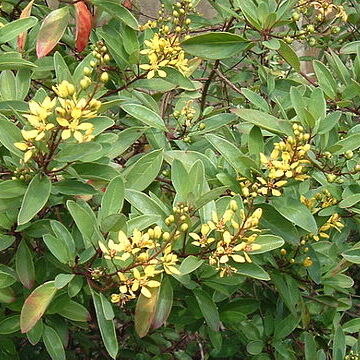Subshrubs or shrubs [occasionally small trees]. Leaves usually bearing glands proximally on blade margin [and/or on petiole]; stipules intrapetiolar, distinct. Inflorescences terminal, racemes [several grouped in panicle]. Pedicels sessile or raised on peduncles. Flowers all chasmogamous, 6+ mm diam., showy with visible petals, stamens, and styles; calyx glands 0 [1 very small gland at base of sinus between some or all adjacent sepals]; corollas nearly radial [moderately bilaterally symmetric], petals lemon yellow, becoming orange or red in age [suffused with red], glabrous [rarely hairy]; stamens 10, all fertile; anthers subequal; pistil 3-carpellate, carpels connate in ovary along broad adaxial faces; styles 3, subulate, slender; stigmas terminal, minute. Fruits schizocarps, breaking apart at maturity into 3 cocci; cocci unwinged, bearing narrow dorsal keel, walls thin, brittle. x = 6.
Low shrubs. Leaves entire, with 2 small glands at the base of the limb. Stipules inserted on the base of the petiole. Racemes terminal, bracteate. Pedicels with 2 bracteoles below the articulation. Flowers bisexual, almost actinomorphic. Sepals 5, mostly glandless, shorter than the petals. Petals distinctly clawed, entire. Filaments 10, not or scarcely connate at the base, the episepalous ones the longest. Ovary globular, 3-lobed, often 1 or 2 cells not developing further; styles 3, free, coiled in bud, divergent, acute. Fruit dry, smooth, mericarps not winged, dehiscent.

